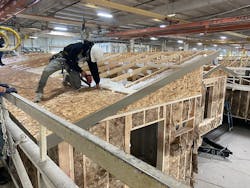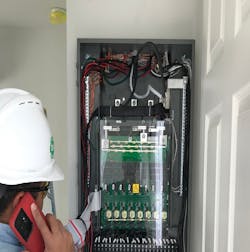EPRI, Buildings group working on making Manufactured Housing all-Electric and Net Zero friendly
Home is where the mobile heart is when it comes to energy efficiency.
Whether it’s called mobile homes or manufactured housing, the U.S. alone has about 43,000 such communities or parks nationwide. The units are less expensive and accessible for lower income residents, but also sometimes are challenged by higher energy costs.
A new project involving the Electric Power Research Institute hopes to improve on the energy side of that residential equation. EPRI has collaborated with the California Energy Commission and the Systems Building Research Alliance (SBRA) on the production of three low-cost, all-electric and Net Zero emissions manufactured home prototypes.
The prototypes are part of an 18-month study happening in California’s Central Valley and San Bernardino County regions. EPRI and SBRA will study those prototypes’ performances on energy use and other factors.
Jan. 11 EnergyTech Webinar featuring EPRI and Enchanted Rock
“While manufactured homes are smaller and more affordable on a first cost basis than their site-built single-family counterparts, on a per square foot basis they typically use larger amounts of energy particularly to heat and cool the premises, increasing their carbon footprint and utility costs for those who typically can least afford it,” Agatha Kazdan, EPRI principal technical leader and project lead, said in a statement.
The results of the study should be available by 2024 with the additional hope of making the best versions scalable.
“Working with SBRA and home fabricator Clayton Homes, EPRI is helping to leverage production and energy efficiencies to produce cost-effective, net-zero manufactured home prototypes,” Kazdan added. “If successful, they could be replicated as affordable housing solutions throughout California, the country, and the world to help meet clean energy targets.”
EPRI is also collaborating with SBRA on similar manufactured housing project demonstrations in the southeastern U.S., in partnership with Southern Company and Tennessee Valley Authority.
Commercial and residential building energy use account for nearly 15 percent of total greenhouse gas emissions in the U.S., according to the Environmental Protection Agency. Most of those emissions stem from energy needs such as heating or cooling, as well as cooking at homes.
Manufactured houses are often less insulated than built-on-site structures, with many built prior to the 2012 Energy Independence and Security Act which upgraded those codes and rules. Newer manufactured homes are built with cutting-edge materials and can be cheaper to heat and cool due to new materials and smaller indoor spaces.
In an era in which real estate and home prices have skyrocketed, a newer, eco-friendly housing alternative could be a game changer for lower income residents.
-- -- --
(Rod Walton, senior editor for EnergyTech, is a 14-year veteran of covering the energy industry both as a newspaper and trade journalist. He can be reached at [email protected]).
Follow us on Twitter @EnergyTechNews_ and @rodwaltonelp and on LinkedIn
About the Author
Rod Walton, EnergyTech Managing Editor
Managing Editor
For EnergyTech editorial inquiries, please contact Managing Editor Rod Walton at [email protected].
Rod Walton has spent 17 years covering the energy industry as a newspaper and trade journalist. He formerly was energy writer and business editor at the Tulsa World. Later, he spent six years covering the electricity power sector for Pennwell and Clarion Events. He joined Endeavor and EnergyTech in November 2021.
Walton earned his Bachelors degree in journalism from the University of Oklahoma. His career stops include the Moore American, Bartlesville Examiner-Enterprise, Wagoner Tribune and Tulsa World.
EnergyTech is focused on the mission critical and large-scale energy users and their sustainability and resiliency goals. These include the commercial and industrial sectors, as well as the military, universities, data centers and microgrids. The C&I sectors together account for close to 30 percent of greenhouse gas emissions in the U.S.
He was named Managing Editor for Microgrid Knowledge and EnergyTech starting July 1, 2023
Many large-scale energy users such as Fortune 500 companies, and mission-critical users such as military bases, universities, healthcare facilities, public safety and data centers, shifting their energy priorities to reach net-zero carbon goals within the coming decades. These include plans for renewable energy power purchase agreements, but also on-site resiliency projects such as microgrids, combined heat and power, rooftop solar, energy storage, digitalization and building efficiency upgrades.


